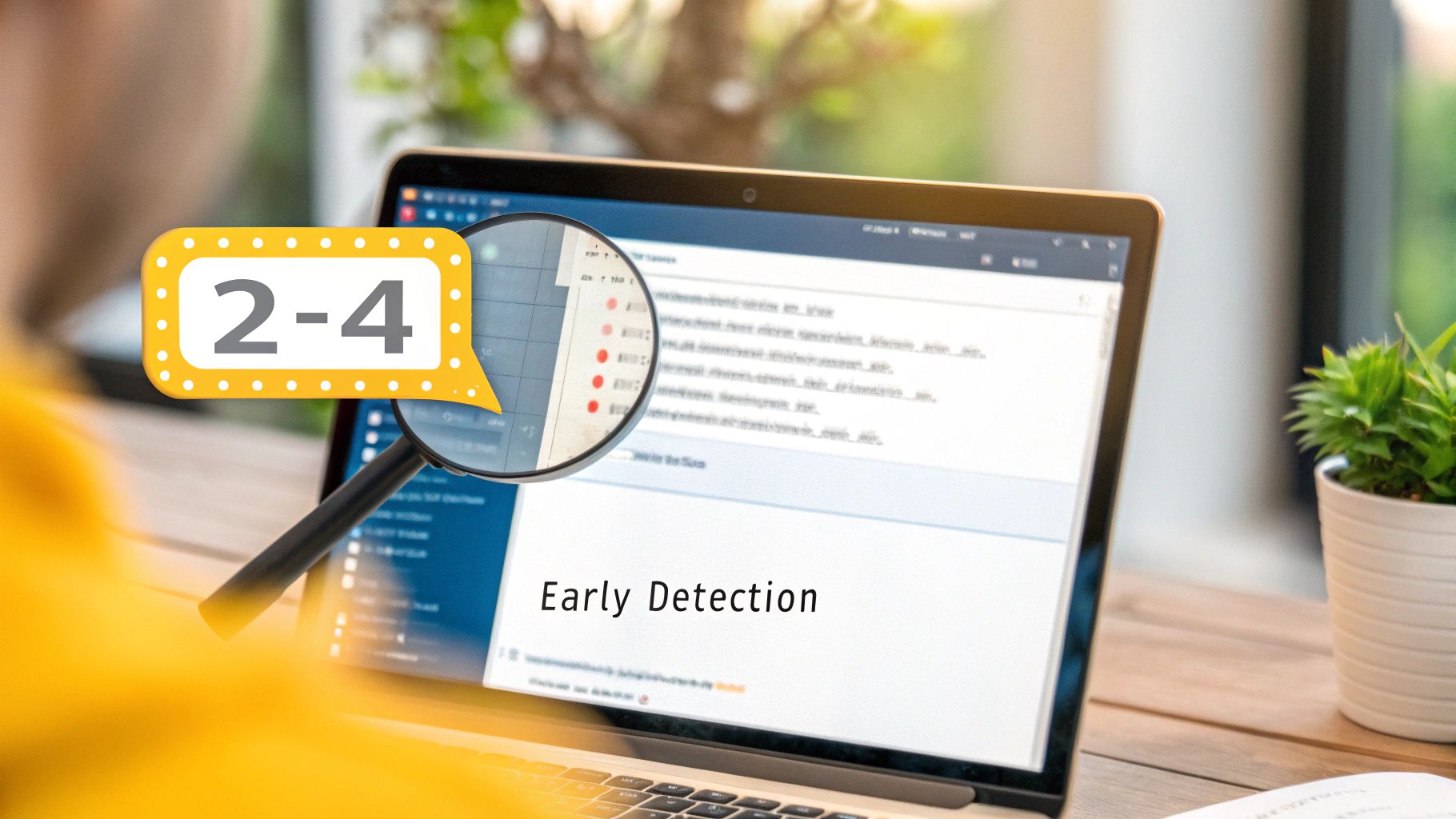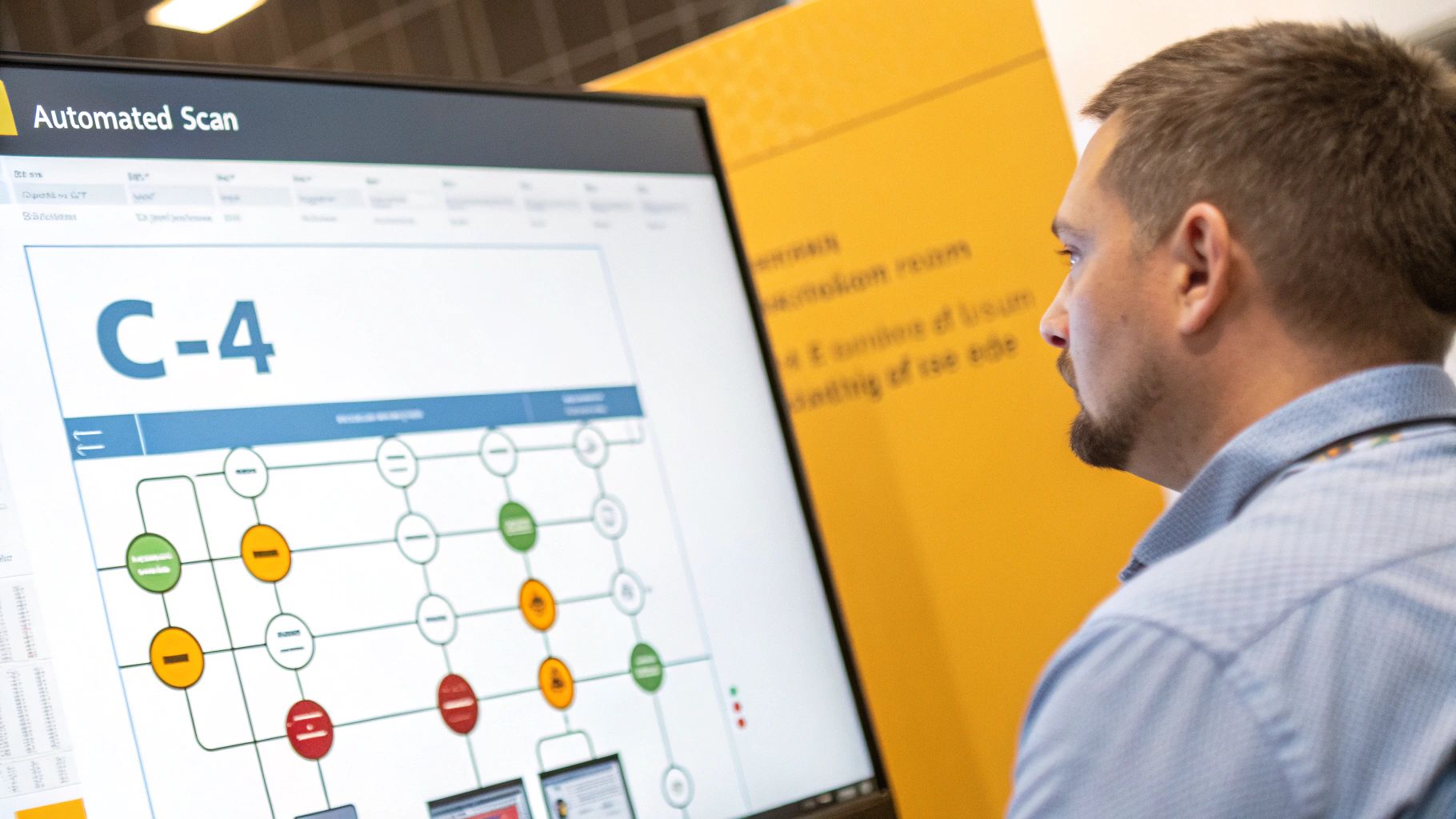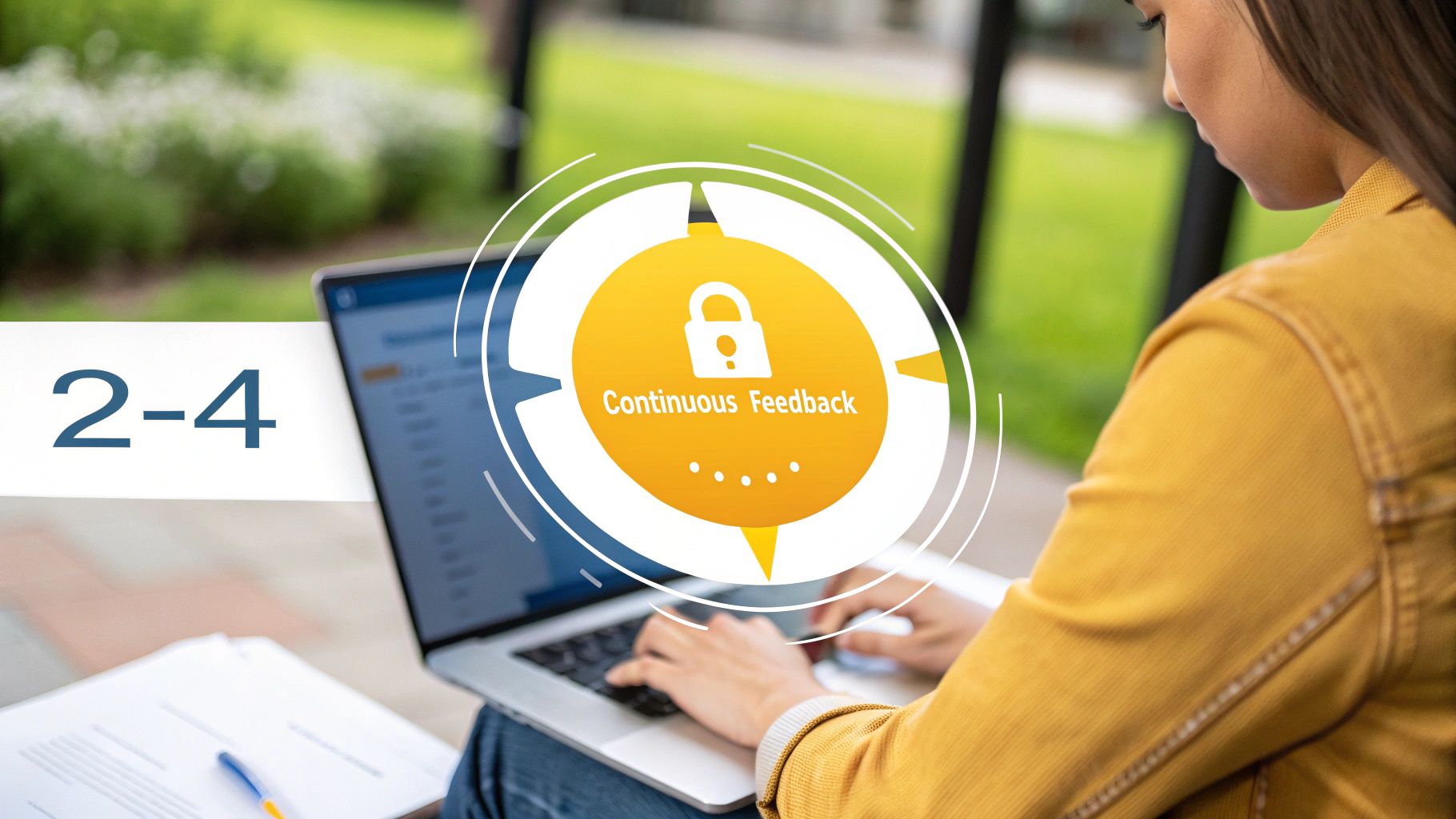Shift Left Security The Ultimate Explainer Guide

Think about building a brand-new house. Would you wait until the walls are painted and the furniture is moved in to check the foundation for cracks? It sounds absurd, but for years, that’s exactly how software security was handled.
This is the core idea behind shift left security. It’s all about moving security from a last-minute inspection at the very end of the process to an ongoing priority from the very beginning. Security becomes a proactive part of building software, not a reactive scramble to fix things before launch.
What Does Shift Left Security Actually Mean?

In a traditional development model, security was an afterthought. The development team would design, code, and test a new application, and only then would they toss it over the wall to a separate security team for a final check. This "shift right" approach was a recipe for disaster, creating huge bottlenecks and unearthing critical flaws just days before a scheduled release.
Finding and fixing bugs this late in the game is not just stressful—it’s incredibly expensive. It also created a natural friction between teams. Developers just wanted to ship cool features, while the security team was often seen as the department of "no."
A Proactive Pivot to the Left
The shift left model completely flips this dynamic. Instead of being a final hurdle, security is woven into every stage of the software development lifecycle (SDLC), from initial planning and coding to testing and deployment. It’s not about dumping more work on developers; it’s about giving them the tools and training to build secure code from the ground up.
This approach grew out of the DevOps movement, which champions collaboration and automation to deliver software faster. Today, shifting security left is a cornerstone of modern development, changing how companies think about risk. To see how this idea is evolving, check out these insights on the future of DevSecOps, which explore its expansion across the entire software supply chain.
The real goal of shifting left isn't just to find bugs earlier. It's to prevent those bugs from ever being written in the first place. This transforms security from a bottleneck into a shared responsibility that actually speeds up development.
Shift Left vs Traditional Security: A Fundamental Comparison
To truly appreciate the difference, think about it like this: the old way was like cramming for a single, high-stakes final exam. The shift left approach is more like having small quizzes and getting continuous feedback all semester long. You learn as you go, and there are no big, costly surprises at the end.
This continuous feedback loop is what makes modern applications so much more resilient. The table below really brings the philosophical and practical differences into sharp focus.
| Attribute | Traditional Security (Shift Right) | Shift Left Security |
|---|---|---|
| Timing | Post-development, just before release. | Continuously, from day one. |
| Cost to Fix | Extremely high and disruptive. | Significantly lower and easier to manage. |
| Responsibility | A siloed security team's problem. | A shared responsibility across all teams. |
| Speed | Creates bottlenecks and slows down delivery. | Accelerates delivery with automated checks. |
| Developer Role | Focused solely on feature creation. | Empowered to write and own secure code. |
| Approach | Reactive and often confrontational. | Proactive and collaborative. |
As you can see, shifting left isn't just a small tweak—it's a complete change in mindset. It moves security from a gatekeeper role to a partner role, leading to faster, safer, and more reliable software for everyone.
The Guiding Principles of a Shift Left Culture

Getting shift left security right is about more than buying a new tool or rewriting a process doc. At its core, it’s a deep cultural transformation. It changes how people think about their roles, their responsibilities, and the daily rhythm of building software.
You're essentially working to weave security into the very fabric of your engineering teams, making it a shared value, not a separate department. It starts by breaking down the old "us vs. them" wall between developers and security. Instead of security being a final, often dreaded, checkpoint, you embed their expertise right into the development flow.
Without this fundamental shift in mindset, even the best tools will just add friction instead of creating value.
From Blame to Shared Responsibility
If there's one principle that matters most, it's shared responsibility. This doesn't mean your developers suddenly need to become cybersecurity gurus overnight. It also doesn’t let the security team off the hook. It’s about creating a true partnership where everyone has a hand in securing the product.
Developers become the first line of defense. They get the training and tools to write secure code from the very beginning. The security team’s role changes, too—they transform from gatekeepers into enablers. They focus on building secure-by-default frameworks, offering expert advice, and tackling the really thorny security problems that require deep specialization.
This model changes everything for the better:
- It empowers developers. They gain the autonomy to find and fix issues in their own environment, which builds a powerful sense of ownership.
- It scales security. A small, specialized security team can now effectively support a much larger engineering organization.
- It builds trust. Silos disappear, communication opens up, and security becomes a team sport instead of a point of contention.
The goal is to move from a culture of "You wrote the bug, you fix it" to one of "We're all building this, so let's make it secure together." It’s a shift from pointing fingers to sharing the load.
The Power of Automated and Continuous Feedback
A culture of shared responsibility needs the right feedback loop to survive. Think about it: if a novelist only got feedback a year after finishing their book, the edits would be jarring and incredibly hard to act on. Developers feel the same way when a security flaw is flagged months after the code was written.
This is where automated, continuous feedback becomes non-negotiable. By plugging security tools directly into the places developers live—their IDEs and CI pipelines—we can give them alerts in real-time.
This immediate feedback is a game-changer for a few key reasons:
- Context is everything. A developer can fix a vulnerability in minutes if they're alerted while the code is still fresh in their mind.
- It creates a learning opportunity. Instant alerts are like a personal tutor, teaching developers about secure coding practices as they go.
- It kills friction. Security stops being a last-minute bottleneck before a release. Problems are found and fixed early, when they're cheapest and easiest to resolve.
This isn’t about catching people making mistakes. It's about giving them a helpful guide that nudges them toward safer code. This proactive approach is what makes shift left security a living part of your culture, helping you build stronger, more resilient products from the inside out.
Why Adopting a Shift Left Strategy Is a Game Changer

Let's move past the theory. The real-world business value of shift left security is something you can take to the bank. This isn't just some minor technical tweak; it's a strategic move that delivers concrete returns. The most obvious and immediate benefit teams see is a massive drop in costs, completely changing the financial picture of cybersecurity.
Think about it this way: what's easier, erasing a line on a skyscraper's blueprint or tearing down a wall after the building is finished? The first is a simple fix. The second is a nightmare of demolition and delays. Software vulnerabilities are exactly the same. A bug found in production can cost over 100 times more to fix than one caught during the initial design phase.
This proactive approach doesn't just save money. It also saves one of your most valuable resources: time.
Accelerate Delivery Speed and Build Momentum
In the old way of doing things, security was often a frantic, last-minute hurdle. It was a gatekeeping process that stalled launches and created a ton of friction between teams. Developers would be scrambling to patch critical issues right before a deadline, leading to delays, burnout, and a whole lot of release-day anxiety.
A shift left strategy completely tears down that bottleneck.
When you integrate automated security checks directly into the development pipeline, potential problems get flagged and fixed early and often. This creates a much smoother, continuous workflow where security actually helps you move faster. Developers can code, test, and deploy with confidence because they know security is already part of the process, not an afterthought.
This constant, early feedback is what keeps the momentum going. Instead of running into a wall of security problems right before launch, teams can stay focused on innovation and getting features out to customers. If you're looking to build out your testing process, our software testing checklist offers a great starting point.
Fortify Your Software and Customer Trust
At the end of the day, we're all trying to build strong, resilient software. Shifting security left is one of the most powerful ways to get there. By hunting down and stamping out vulnerabilities all through the development lifecycle, you end up with a final product that is just fundamentally more secure.
Shifting left changes security from a reactive patch-up job into a proactive, quality-focused discipline. The result isn't just safer code—it's better, more reliable software that people can trust.
This improved resilience creates a powerful ripple effect. When customers feel their data is safe, they trust your brand. In a world where data breaches are constantly in the news, a solid security posture is a huge competitive advantage. It strengthens your reputation and helps build the kind of customer loyalty that lasts.
The market is already voting with its wallet. The focus on proactive security is driving huge growth in the global application security market, which is expected to skyrocket. This isn't a fluke; it's a direct response to rising cyber threats and the growing awareness that building security in from the start is the only way forward. Adopting a shift left strategy isn't just about keeping up—it's about setting your business up for a more secure and successful future.
A Practical Roadmap to Implement Shift Left Security

So, you’re sold on the idea of shift left security, but turning it into a reality can feel daunting. The good news? You don't have to overhaul everything at once. The trick is to see this as a continuous evolution, not a one-and-done project with a hard deadline.
Think of it like getting in shape. You wouldn't just show up and run a marathon on your first day. You'd start with a walk, maybe a light jog, and slowly build up your endurance. We’ll apply that same mindset here: start small, get some quick wins, and then scale those successes across your development lifecycle.
Stage 1: It All Starts Before a Single Line of Code is Written
That’s right. A true shift left approach kicks off way before anyone opens a code editor. Security has to have a seat at the table during the design and planning phase. This is your golden opportunity to design vulnerabilities out of the system before they even have a chance to exist.
The key activity here is threat modeling. This isn't some dark art; it's a structured brainstorming session where your team puts on its "black hat" and thinks like an attacker. You get around a whiteboard (virtual or physical) and start asking the tough questions:
- What’s the most valuable data this feature will touch?
- If I wanted to break this, how would I do it?
- Where are the weak spots in this initial design?
By mapping out these threats early, you can build security controls directly into the application's architecture. Honestly, it's a thousand times easier—and cheaper—to fix a design on a whiteboard than to patch a fundamental flaw in a live product.
Stage 2: Secure the Code as It's Being Typed
Once the coding starts, the focus moves to empowering your developers. They are your first and most important line of defense. The goal is to give them immediate, real-time feedback on their code’s security, right inside the development tools they already use and love.
This is where Static Application Security Testing (SAST) tools come into play. A SAST tool acts like a spell-checker for security flaws, automatically scanning source code for common vulnerability patterns like SQL injection or cross-site scripting. By integrating it directly into an IDE or as a pre-commit hook, developers see an alert the moment they write a risky piece of code, letting them fix it instantly while the logic is still fresh in their mind.
Shifting left isn’t about burdening developers with another tedious checklist. It’s about weaving security into their workflow so seamlessly that writing secure code becomes the easiest and most natural option.
SAST is a cornerstone of this whole approach, and you can see its importance in the market's growth. Big names like Checkmarx and Veracode are leading the charge here, helping teams embed these checks directly into their daily work.
Stage 3: Automate Security in the Build and Test Pipeline
As code gets committed and enters your CI/CD pipeline, your security automation needs to kick into high gear. Now, you’re not just looking at your own code, but also at all the third-party dependencies you’re pulling in. You also need to test how the application behaves when it's actually running.
Two key pieces of tech make this happen:
- Software Composition Analysis (SCA): Let's be real—modern apps are mostly assembled from open-source libraries. SCA tools are essential for scanning these components for known vulnerabilities, protecting you from supply chain attacks that exploit someone else’s buggy code.
- Dynamic Application Security Testing (DAST): While SAST reads the blueprint, DAST tries to rattle the doors of the finished house. It tests the running application from the outside in, just like an attacker would, to find runtime issues like server misconfigurations or broken authentication.
This stage is all about leveraging the power of automation. Integrating SCA and DAST into your CI/CD pipeline means every single build gets a security shakedown automatically. This dovetails perfectly with the principles of quality assurance in software development, creating a powerful safety net that catches flaws before they ever reach users.
Stage 4: Pilot, Measure, and Grow
Trying to force shift left security on an entire organization at once is a recipe for failure. The smartest way to get buy-in is to start with a pilot program. Pick one team that’s open to new ideas and a project that's not too simple but not mission-critical either.
Your mission is to make this pilot an undeniable success story. To do that, you need to track everything. Focus on metrics that tell a powerful story:
- The reduction in vulnerabilities that make it to pre-production testing.
- The time and money saved by catching bugs in the IDE versus in production.
- Developer feedback on how the new tools are helping, not hindering, them.
With this data in hand, you can build an ironclad business case for expanding the program. A real, proven success story from one of your own teams is far more convincing than any slide deck. Start small, prove the value, and use that momentum to fundamentally change your organization's approach to security.
The Tech Stack That Makes Shifting Left Possible
Let’s be honest: a shift left strategy can't run on good intentions alone. It's powered by a very specific set of tools that automate security checks and give developers instant feedback. Think of these as the high-tech sensors and scanners in our skyscraper analogy—they find the tiny cracks in the foundation long before the building starts to lean. These tools plug directly into the developer's daily workflow, making security a natural part of writing code, not a roadblock that shows up at the last minute.
To get started, you need to understand the alphabet soup of security tooling: SAST, DAST, SCA, and IAST. It sounds like jargon, but each one has a distinct job and works best at a specific point in the development process. Let's break down what they are, what they actually do, and how they fit together to build a strong, layered defense. The ultimate goal is to weave security so deeply into your process that doing the right thing becomes the easiest and most obvious choice for your developers.
Scanning the Blueprints with SAST
Static Application Security Testing (SAST) tools are your first line of defense, and they get involved very early. Think of a SAST tool as a meticulous proofreader for your source code. It scans your code for security flaws before the application is even built or run. This is as "left" as you can get, and it’s where you’ll find the cheapest fixes.
A SAST tool reads the raw code, looking for patterns that lead to common attacks like SQL injection, buffer overflows, or cross-site scripting (XSS). Because it has direct access to the code, it can tell you the exact file and line number where a problem exists.
By plugging a SAST tool directly into a developer's code editor (their IDE) or as a check before they can even commit their code, you create an incredibly tight feedback loop. What could have been a week-long headache to fix later becomes a five-minute tweak, because the context is still fresh in the developer's mind.
Securing Your Supply Chain with SCA
Today, almost no application is built entirely from scratch. Developers pull in hundreds of open-source libraries and third-party components to speed things up. While this is great for productivity, it's also a huge source of risk. How do you know that free library you just downloaded doesn't have a critical vulnerability?
This is where Software Composition Analysis (SCA) tools come in. They are absolutely essential for managing modern software development. SCA tools do two main things:
- Build an Inventory: They scan your project and create a complete list of every open-source piece you're using. This list is often called a Software Bill of Materials (SBOM).
- Check for Vulnerabilities: They then compare that inventory against global databases of known vulnerabilities (like CVEs), immediately telling you if you’re using a component with a known security hole.
With supply chain attacks becoming more common, you simply can't afford to be blind to what's inside your code. An SCA tool is your best defense against inheriting someone else's security problems.
Testing the Live Application with DAST
While SAST checks the blueprints, Dynamic Application Security Testing (DAST) tools test the finished structure. A DAST tool is like a friendly, automated ethical hacker. It doesn't look at your source code at all. Instead, it attacks your application from the outside, just like a real attacker would.
It pokes and prods your running web application or API, sending all sorts of weird and malicious-looking requests to see how it reacts. This approach is fantastic for finding runtime issues that SAST can't see, such as:
- Problems with your server configuration.
- Flaws in how you handle user logins and sessions.
- Vulnerabilities that only pop up when different services interact with each other.
DAST is typically unleashed in a QA or staging environment. It gives you that critical "outside-in" view of your security before your customers—or attackers—get a chance to find the same holes.
Getting Real-Time Feedback with IAST
So, what if you could combine the "inside" view of SAST with the "outside" view of DAST? That's exactly what Interactive Application Security Testing (IAST) does. It’s a hybrid approach that works from inside the running application.
You install an IAST agent that instruments your code, and it sits there monitoring everything in real time. When someone runs a test (whether it's an automated DAST scan or a manual QA tester), the IAST agent watches how the code responds from the inside. If it sees a dangerous behavior, it can pinpoint the exact line of code that caused the problem. This gives developers incredibly accurate feedback with almost no false positives, making it a powerful addition to your automated testing in the CI/CD pipeline.
The Future of Development Is Secure by Design
When you zoom out and look at the bigger picture, shift left security isn't just another buzzword or a tweak to your workflow. It's a genuine evolution in how modern software gets made. Think of it as a cultural shift, where development, security, and operations teams stop working in silos and start collaborating toward one shared goal: building amazing, secure products right from the get-go.
This approach flips the script on security, turning it from a dreaded cost center into a real strategic advantage for the business. When security is woven into every stage of development, your teams can innovate and ship new features faster and with more confidence. You're not just playing whack-a-mole with bugs at the end; you're proactively building quality and resilience directly into the product's DNA.
Security as a Core Business Function
In a world filled with sophisticated supply chain attacks and ever-present digital risks, a proactive security stance isn’t just a nice-to-have anymore. It’s a matter of survival and growth. The old way of treating security as a final checkpoint before launch is painfully slow and leaves you wide open to risk. The future belongs to companies that see security as a core part of how they do business, period.
Shifting left is really about making security everyone’s job, not just a problem for the security team to clean up later. It’s about empowering developers with the right tools and knowledge when they need them most, so they can make secure choices on their own.
When you make this cultural change, security can finally keep pace with development, making your whole organization more agile and resilient. The focus shifts from frantically hunting for flaws before a release to designing systems that are secure from the ground up.
A Path to Continuous Improvement
At the end of the day, embedding security from the start leads to better software, stronger customer trust, and a serious competitive edge. It’s not a one-and-done project but a continuous journey of improvement. You have to keep checking your work. For a practical guide on this, our article on conducting a comprehensive website security audit offers some great, actionable steps.
By adopting this secure-by-design mindset, you’re setting your organization up to not only defend against today’s threats but also to confidently tackle whatever comes next. You’re simply building faster, safer, and smarter.
Your Questions About Shift Left Security, Answered
Making the leap to a shift left security model naturally brings up a lot of questions. Teams often wonder about how roles will change, what it will cost, and how this all fits in with other practices like DevSecOps. Getting clear on these points is crucial for getting everyone on board and making the transition a smooth one.
Let's tackle some of the most common questions head-on to clear up the confusion and turn these ideas into something your teams can actually use.
Does Shift Left Mean Developers Suddenly Do All the Security Work?
No, and this is probably the biggest myth out there. The idea isn't to take the security workload and just dump it on developers. It’s about building a culture of shared responsibility where security becomes part of everyone's job, not just one team's problem.
Think of it as empowering developers to be the first line of defense. By giving them the right tools and quick feedback, they can catch and fix common security bugs right as they’re writing code.
But the security team doesn't disappear—their role just evolves. They get to stop being gatekeepers and start being expert advisors. They can then focus on higher-impact work, like:
- Setting up security policies and guardrails for the whole organization.
- Conducting deep-dive threat modeling and penetration tests on critical systems.
- Managing complex security incidents and high-level architectural risks.
- Coaching developers and championing secure coding practices across teams.
It’s a true partnership, not just a handoff.
The real goal of "shifting left" is to weave security expertise into the entire development process. It's a team sport, with security pros and developers playing on the same side.
Can We Shift Left Without Buying a Bunch of Expensive Tools?
Absolutely. While there are some incredibly powerful security tools on the market, you don't need a huge budget to start making a real difference. At its heart, shifting left is a change in mindset and process, and some of the best first steps are free.
You can kick things off with simple, high-impact changes:
- Peer Code Reviews: Start by making security a required part of every code review discussion.
- Secure Coding Checklists: Develop and share a simple, straightforward list of security best practices for your team.
- Informal Threat Modeling: Just get people in a room during the design phase to brainstorm what could go wrong. It doesn't have to be a formal, week-long affair.
Plus, there’s a whole world of excellent open-source security tools that can help you scan code and check for vulnerable dependencies without spending a dime. The culture change comes first; the fancy tools can come later.
How Is This Different From DevSecOps?
That's a fantastic question, as the two concepts are definitely intertwined. Here’s a simple way to think about it: DevSecOps is the overarching philosophy of baking security into every step of the DevOps pipeline. It's the "what" and the "why."
Shift left security is one of the most important ways you actually do DevSecOps. It's the practical "how."
When you move security checks and considerations earlier in the development lifecycle, you are putting the DevSecOps philosophy into action. They aren't competing ideas; they're two sides of the same coin. Shifting left is a core principle that brings the entire culture of DevSecOps to life.